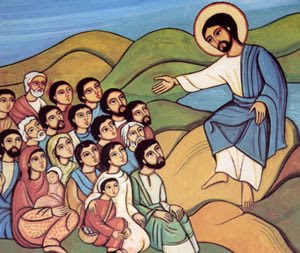 When Jesus was, we believe, around thirty years old, he left his home and his family and began a career as a traveling rabbi. He would travel around the country, with his closest followers, and talk to people about his ideas. In addition, he acquired a reputation as a healer, which attracted even more people to hear him. Jesus’ message was a deceptively simple one. He taught that God loved each individual person and that all we had to do was to accept that love and love God in return. This message was somewhat unusual at the time because of Jesus’ personal image of God; God is a Father, a Dad, who loves us unconditionally.
When Jesus was, we believe, around thirty years old, he left his home and his family and began a career as a traveling rabbi. He would travel around the country, with his closest followers, and talk to people about his ideas. In addition, he acquired a reputation as a healer, which attracted even more people to hear him. Jesus’ message was a deceptively simple one. He taught that God loved each individual person and that all we had to do was to accept that love and love God in return. This message was somewhat unusual at the time because of Jesus’ personal image of God; God is a Father, a Dad, who loves us unconditionally.
Jesus used a variety of teaching tools to get his message across to the people who came to hear him. He used a straightforward didactic method in which he just explained what he wanted to teach; think of the Sermon on the Mount. He taught by example; for example, he showed his disciples how to pray by giving them a sample prayer, the Our Father, and by taking time by himself to pray. And, finally, he used parables and miracles to capture the attention of regular people.
A parable is a short, fictional story that explains some deeper idea in a way that people can understand. For example, rather than trying to explain to people that God loves them and will forgive them if they sin, Jesus told the parable of the Prodigal Son. In this parable, Jesus explained that God is like a loving father who gives his children every good thing even when they will misuse those gifts and who always forgives his children when they return to him. Most people have had the experience of being loved and forgiven by a family member and this made it a lot easier to understand Jesus point about how God loves us.
A miracle is an event that, at the time that it happens, had no logical explanation. Throughout the Gospels, Jesus performed many miracles for a variety of people in all kinds of situations. Although many modern scholars and scientists believe that some of Jesus’ miracles can be explained away, we still consider them to be miracles because they were unexplained phenomena at the time. Jesus’ miracles fall into three categories. The first type of miracle is the healings, miracles in which Jesus cures a person of a disease or physical ailment. This category would include the healing of lepers, lame people, blind people, and so on. The second category, raisings from the dead, includes the several times that Jesus brought people back to life after they had died. The third category is physical miracles; these are miracles that show Jesus’ power over the forces of nature. In many cases, when Jesus performed a miracle, it was in a private setting with only a few people witnessing it and he would often tell those witnesses to tell no one of what they had seen. Jesus did not perform miracles in order to “wow” a crowd of people; he performed them because he saw that people were suffering and he wanted to alleviate that suffering. Therefore, we believe that Jesus did not want the witnesses of his miracles to be amazed, he wanted their faith to be increased.
Jesus’ ministry has become, for Christians, both the content of much of our own preaching – that God loves us and that we are called to love our neighbors – and the example of how to engage in God’s ministries. Jesus didn’t just teach with word, but with deeds; we follow his example when our actions become our evangelization tools. As St. Francis of Assisi reminds us: “Preach the Gospel at all times; if necessary, use words.”










